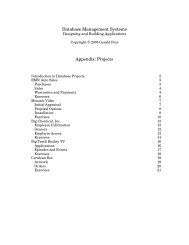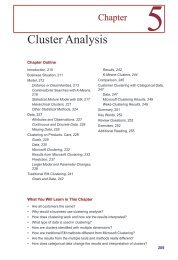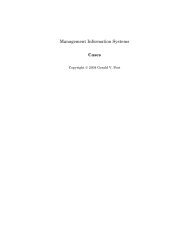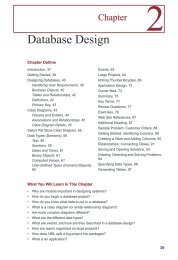Database Projects/5e - Professor Jerry Post
Database Projects/5e - Professor Jerry Post
Database Projects/5e - Professor Jerry Post
You also want an ePaper? Increase the reach of your titles
YUMPU automatically turns print PDFs into web optimized ePapers that Google loves.
Project Descriptions<br />
separate. Partly because it highlights the importance of the labor that is a critical<br />
factor in his shop, and partly because he likes to see the separate totals when he<br />
looks back over old projects when estimating costs of new jobs. Notice that both<br />
the parts and labor are identified by phases of the project. For complete overhauls,<br />
these phases are relatively standard, including dismantling, work on the frame,<br />
body work, painting, interior, engine, exhaust, and electrical. The phases are used<br />
as categories that he uses to compare time and cost values across projects. For instance,<br />
he wants to be able to run a query that tells him the average time spent on<br />
building interiors.<br />
Exercises<br />
1. Create the feasibility study (initial proposal).<br />
2. Create a list of all of the forms and reports that the company might use.<br />
3. Create a normalized list of tables for each form and report.<br />
4. Create an integrated list of normalized tables for the entire application. Draw<br />
the corresponding class diagram.<br />
5. Create the basic tables in a DBMS along with all necessary relationships and<br />
integrity constraints. Enter sample data into the tables to test your design.<br />
6. Evaluate the normalized tables and estimate the size of the database—both<br />
current size and estimated size in 3 years.<br />
7. List the initial security conditions for the data tables. Create a list of user<br />
groups and identify their basic access needs.<br />
8. Design the overall structure of the application. Outline the overall structure<br />
and the primary forms. Select a design scheme, including layouts, effects,<br />
and colors.<br />
9. Build three initial input forms.<br />
10. Build three initial reports.<br />
11. Improve the forms and reports to make them easier to use.<br />
12. Test your forms and reports with sample users.<br />
13. Build additional forms and reports. Improve all of them. Test all of them.<br />
14. Connect all of the forms and reports into an application. Add help files. Test<br />
all the links. Test the forms and reports. Check for consistency.<br />
15. Add security, backup and recovery, and other management features to the<br />
application.<br />
16. Move the data tables to a centralized server, leaving the application to run on<br />
a client. Build the necessary links and retest the application.<br />
17. Move the entire application to a Web server. Build the forms so that they run<br />
on a Web browser.<br />
18. Create an OLAP evaluation query and graphs. Build in a way to create the<br />
links so new annual data can be generated automatically. Link the data so that<br />
the spreadsheet is updated automatically.<br />
37







